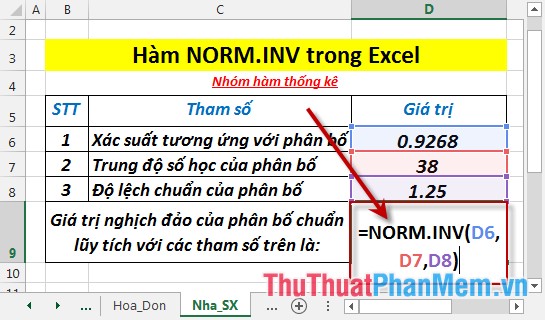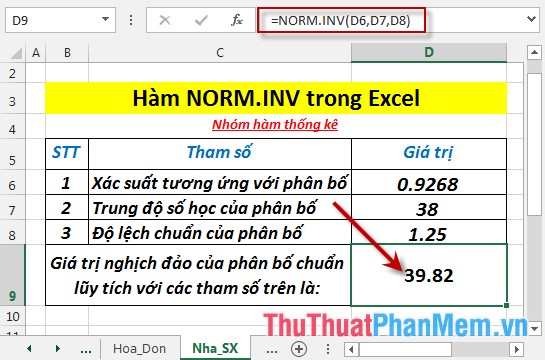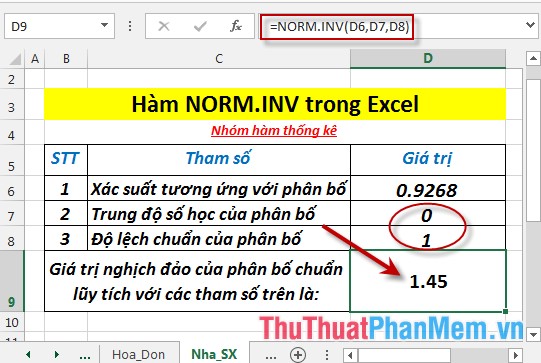NORM.INV function - The function returns the inverse of the standard cumulative distribution in Excel
The following article introduces you to the NORM.INV function - one of the functions in the group of statistical functions that is very popular in Excel.

Description: The function returns the inverse of the standard cumulative distribution with the specified standard deviation and mean. Support functions from Excel 2010 onwards.
Syntax: NORM.INV (probability, mean, standard_dev)
Inside:
- probability: Probability corresponding to the normal distribution, is a required parameter .
- mean: Arithmetic mean of distribution, is a required parameter.
- standard_dev: The standard deviation of the distribution, is a required parameter.
Attention:
- If any argument of the function is not a number -> the function returns the #VALUE! Error value
- If standard_dev ≤ 0 -> the function returns the #NUM! Error value
- If mean = 0 , standard_dev = 1 -> function returns normalized distribution.
For example:
Find the inverse value of the cumulative normal distribution with the values in the data table below:

- In the cell to calculate, enter the formula : = NORM.INV (D6, D7, D8)

- Press Enter -> the inverse value of the cumulative standard distribution is:

- Where mean = 0 , standard_dev = 1 -> function returns normalized distribution.

- Where standard_dev ≤ 0 -> the function returns the #NUM! Error value

Above are instructions and some specific examples when using the NORM.INV function in Excel.
Good luck!
You should read it
- NORM.DIST function - The function returns the normal distribution with the standard deviation and the mean value specified in Excel
- BETA.INV function - The function returns the inverse of the cumulative distribution function for a specified beta distribution in Excel
- LOGNORM.INV function - The function returns the inverse of the logarithmic distribution of x in Excel
- GAMMA.INV function - The function returns the inverse of the gamma distribution in Excel
- NORMINV function - The function returns the inverse of the cumulative distribution in Excel
- T.INV function - The function returns the inverse value of the Student t distribution in Excel
 NORM.S.DIST function - The function returns the normalized distribution with a mean of 0 and a standard deviation of 1 in Excel
NORM.S.DIST function - The function returns the normalized distribution with a mean of 0 and a standard deviation of 1 in Excel PEARSON function - The function returns the Pearson product moment correlation coefficient in Excel
PEARSON function - The function returns the Pearson product moment correlation coefficient in Excel PERCENTILE.EXC function - The function returns the kth percentile of values in the range, with k in the range from 0 to 1 in Excel
PERCENTILE.EXC function - The function returns the kth percentile of values in the range, with k in the range from 0 to 1 in Excel PERCENTILE.INC function - Function returns the kth percentile of values in the range with k in the range from 0 to 1 in Excel
PERCENTILE.INC function - Function returns the kth percentile of values in the range with k in the range from 0 to 1 in Excel PERMUT function - The function returns the number of permutations of a given number of objects in Excel
PERMUT function - The function returns the number of permutations of a given number of objects in Excel PERMUTATIONA function - The function returns the number of permutations (can be repeated) of a given object in Excel
PERMUTATIONA function - The function returns the number of permutations (can be repeated) of a given object in Excel